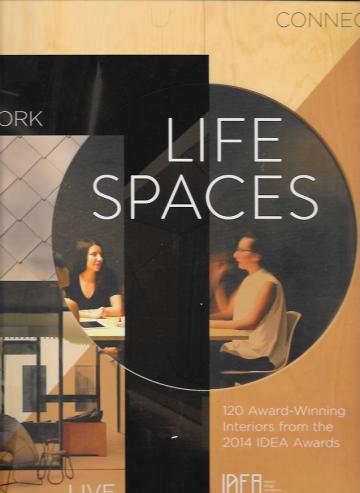
Examining a selection of entrants from the 2014 IDEA Awards, Life Spaces is brimming with the most sumptuous and well-designed interiors to have been built in Australia that year. The 120 inclusions were narrowed down from the original 500 entries into the competition and cover a very wide variety of different structures, from single- and multi-residential blocks to workplaces, restaurants and public spaces.
The book is divided into three sections, titled ‘Live’, ‘Work’ and ‘Connect’, and within those it roughly groups buildings with similar structures, making for a very straightforward layout. Life Spaces also does not use many title pages or chapter breaks, meaning that the flow of information is very fluid throughout the entire book. The layout of the pages prioritises large, full gloss photographs that are accompanied by small-to-medium pieces of text that, while sometimes not providing a full overview of the structure, highlight the points that the architects think most worthy of note. It should be noted here that, as the textual accompaniments were written by the designers of the buildings and not the judges of the IDEA Awards, the language that is used tends towards the flowery and does in some cases read a little hyperbolic. However, the editing does provide a coherent tone over the top, and so while this tendency is noticeable it is not overpowering.
The first section looks at sub-1000m2 single family homes. The smallest of the included projects, these are all quite different as the clientele are able to have a large influence over the final product. As such, these interiors have a wide variety in their furnishings and are very purposefully designed to showcase those who will live within them. The very first inclusion, the Pittwater House (6), is a fine example of the extreme design quality that these houses have. It uses large swathes of wood throughout the interior, which is certainly a theme with the small residences; timber is used in almost every inclusion, particularly throughout the livings space. The Great Ocean Road House (40) goes beyond that, using wood without exception throughout.
The single-family residences are all exceptionally well built, but they are not too adventurous in their designs. This is likely because a house for a family, especially in an inner-city location, will be made up of the same parts as any other house—bedroom, bathroom, kitchen, etc.—. and so the designs will not be too different from each other. The multi-residential buildings are few in number within the pages of Life Spaces, but they have allowed their designers a little more leeway in how they create a community by combining the intimacy of private homes with common spaces available for use by all. For example, The Commons (78) has sumptuous dark wood floorboards within the apartments that make for cosy nest-like spaces, and a small communal garden on the top of the building with weathered plank decking surrounding it that ties it to the balconies of the residences.
The sections on residential projects make up a much smaller proportion of the book than do the professional buildings. Two sections look at workplaces, one for those under 1000m2 and one for those over, and they are much larger and showcase layouts with much more variation. From small start-ups in repurposed warehouses to large, multi-national corporations in skyscrapers, the interiors here range over many different styles with many different materials used. Wood sees a great deal of use in the smaller, less traditional workspaces, such as the Goodmann T2 workplace fitout (150), which uses timber cladding on the interior to create warm spaces that are separated from the main work areas, or the SBS Pilot Space (230), which also uses wood to isolate spaces from the main section with its exposed ceiling. Ansarada Office (184) is at the very extreme of timber use, having a luxurious all-wood interior from floorboards to ceiling with beautiful caramel, tan and chocolate colours. The larger buildings tend towards a more usual, steel-and-concrete construction with timber used accentually.
The final two sections of Life Spaces look at hospitality and public spaces, and one of the most immediately notable points from here is the extent to which the design can become highly stylised and very unique as compared to the previous inclusions, such as in Zhou Zhou (298), a Chinese-centric beer bar with a very obvious design aesthetic. There is also a large element of the sculptural in these projects, such as the bent-iron curtain of the Claremont House Driveway (358) or the Bentley Restaurant and Bar (308) with its “tectonic black scaffolding”, as described by the designer. These projects, in their search to brand themselves and to create unique spaces, do not seem to turn to wood as the building material of choice, instead preferring the malleability of concrete and steel. It remains to be seen whether, in later years of the IDEA Awards, new wood products might make an impact on these types of buildings and sculptural installations.
Taking an extremely wide view of the building industry in Australia, Life Spaces is a fantastic book; it manages to give what feels like plenty of space to each inclusion through its inspection of all 120 separate structures. The book is certainly a little too large to read on the go, but has a perfect design to sit on a coffee table and demands to be leafed through as it showcases the height of Australian architectural and interior design.
